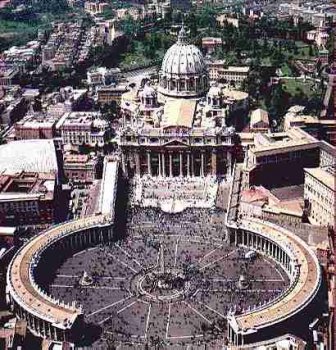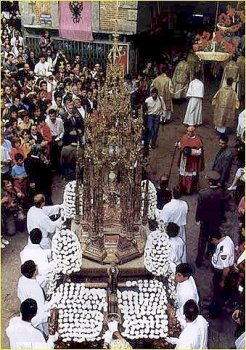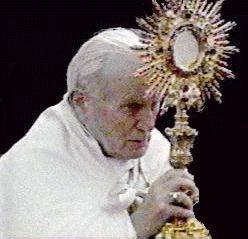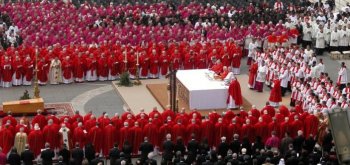That kind of error is an anti-Catholic invention and not what the Church teaches. I've posted actual teaching at least twice (post #100, 111) but your irrational anger and hostility has you blinded, which makes any discussion with you pointless. You can't stop with your stupid flaming zingers. You have been flooding this thread with hostile post after hostile post and I didn't have time to expose "Fox's Book of Martyrs" deemed unreliable by real historians. It's as phony as...
OK, so you want to talk about the Eucharist?
Stop with your stupid flaming zingers, it's a tactic you use whenever you are confronted with the truth. And what is the point when you ignore all my posts?
Would you like to start at the 1st century beliefs or are they too Catholic for you? Or how about the 15th century when the first time the teaching was opposed? A bit late in history don't you think? (which is why you are forced to tear down so it matches what you don't have) How about we start with John 6?
You don't believe what has been taught by Jesus and the Apostles about the Eucharist because you haven't enough faith. I will give you some links that you won't read because you just want to fight, argue and hurl flaming zingers so their is little point in discussing the Eucharist with you.
https://www.scripturecatholic.com/the-eucharist/
http://www.vatican.va/archive/ccc_css/archive/catechism/p2s2c1a3.htm
Christ in the Eucharist | Catholic Answers
Protestant attacks on the Catholic Church often focus on the Eucharist. This demonstrates that opponents of the Church—mainly Evangelicals and Fundamentalists—recognize one of Catholicism’s core doctrines. What’s more, the attacks show that Fundamentalists are not always literalists. This is seen in their interpretation of the key biblical passage, chapter six of John’s Gospel, in which Christ speaks about the sacrament that will be instituted at the Last Supper. This tract examines the last half of that chapter.
John 6:30 begins a colloquy that took place in the synagogue at Capernaum. The Jews asked Jesus what sign he could perform so that they might believe in him. As a challenge, they noted that "our ancestors ate manna in the desert." Could Jesus top that? He told them the real bread from heaven comes from the Father. "Give us this bread always," they said. Jesus replied, "I am the bread of life; whoever comes to me will never hunger, and whoever believes in me will never thirst." At this point the Jews understood him to be speaking metaphorically.
Again and Again
Jesus first repeated what he said, then summarized: "‘I am the living bread which came down from heaven; if any one eats of this bread, he will live for ever; and the bread which I shall give for the life of the world is my flesh.’ The Jews then disputed among themselves, saying, ‘How can this man give us his flesh to eat?’" (John 6:51–52).
His listeners were stupefied because now they understood Jesus
literally—and correctly. He again repeated his words, but with even greater emphasis, and introduced the statement about drinking his blood: "Truly, truly, I say to you, unless you eat the flesh of the Son of man and drink his blood, you have no life in you; he who eats my flesh and drinks my blood has eternal life, and I will raise him up at the last day. For my flesh is food indeed, and my blood is drink indeed. He who eats my flesh and drinks my blood abides in me, and I in him" (John 6:53–56).
No Corrections
Notice that Jesus made no attempt to soften what he said, no attempt to correct "misunderstandings," for there were none. Our Lord’s listeners understood him perfectly well. They no longer thought he was speaking metaphorically. If they
had, if they mistook what he said, why no correction?
On other occasions when there was confusion, Christ explained just what he meant (cf. Matt. 16:5–12). Here, where any misunderstanding would be fatal, there was no effort by Jesus to correct. Instead, he repeated himself for greater emphasis.
In John 6:60 we read: "Many of his disciples, when they heard it, said, ‘This is a hard saying; who can listen to it?’" These were his disciples, people used to his remarkable ways. He warned them not to think carnally, but spiritually: "It is the Spirit that gives life, the flesh is of no avail; the words that I have spoken to you are spirit and life" (John 6:63; cf. 1 Cor. 2:12–14).
But he knew some did not believe. (It is here, in the rejection of the Eucharist, that Judas fell away; look at John 6:64.) "After this, many of his disciples drew back and no longer went about with him" (John 6:66).
This is the only record we have of any of Christ’s followers forsaking him for purely doctrinal reasons. If it had all been a misunderstanding, if they erred in taking a metaphor in a literal sense, why didn’t he call them back and straighten things out? Both the Jews, who were suspicious of him, and his disciples, who had accepted everything up to this point, would have remained with him had he said he was speaking only symbolically.
But he did not correct these protesters. Twelve times he said he was the bread that came down from heaven; four times he said they would have "to eat my flesh and drink my blood." John 6 was an extended promise of what would be instituted at the Last Supper—and it was a promise that could not be more explicit. Or so it would seem to a Catholic. But what do Fundamentalists say?
Merely Figurative?
They say that in John 6 Jesus was not talking about physical ood and drink, but about spiritual food and drink. They quote John 6:35: "Jesus said to them, ‘I am the bread of life; he who comes to me shall not hunger, and he who believes in me shall never thirst.’" They claim that coming to him is bread, having faith in him is drink. Thus, eating his flesh and blood merely means believing in Christ.
But there is a problem with that interpretation. As Fr. John A. O’Brien explains, "The phrase ‘to eat the flesh and drink the blood,’ when used figuratively among the Jews, as among the Arabs of today, meant to inflict upon a person some serious injury, especially by calumny or by false accusation. To interpret the phrase figuratively then would be to make our Lord promise life everlasting to the culprit for slandering and hating him, which would reduce the whole passage to utter nonsense" (O’Brien,
The Faith of Millions, 215). For an example of this use, see Micah 3:3.
Fundamentalist writers who comment on John 6 also assert that one can show Christ was speaking only metaphorically by comparing verses like John 10:9 ("I am the door") and John 15:1 ("I am the true vine"). The problem is that there is not a connection to John 6:35, "I am the bread of life." "I am the door" and "I am the vine" make sense as metaphors because Christ is like a door—we go to heaven through him—and he is also like a vine—we get our spiritual sap through him. But Christ takes John 6:35 far beyond symbolism by saying, "For my flesh is food indeed, and my blood is drink indeed" (John 6:55).
He continues: "As the living Father sent me, and I live because of the Father, so he who eats me will live because of me" (John 6:57). The Greek word used for "eats" (
trogon) is very blunt and has the sense of "chewing" or "gnawing." This is not the language of metaphor.
Their Main Argument
For Fundamentalist writers, the scriptural argument is capped by an appeal to John 6:63: "It is the spirit that gives life, the flesh is of no avail; the words that I have spoken to you are spirit and life." They say this means that eating real flesh is a waste. But does this make sense?
Are we to understand that Christ had just commanded his disciples to eat his flesh, then said their doing so would be pointless? Is that what "the flesh is of no avail" means? "Eat my flesh, but you’ll find it’s a waste of time"—is that what he was saying? Hardly.






